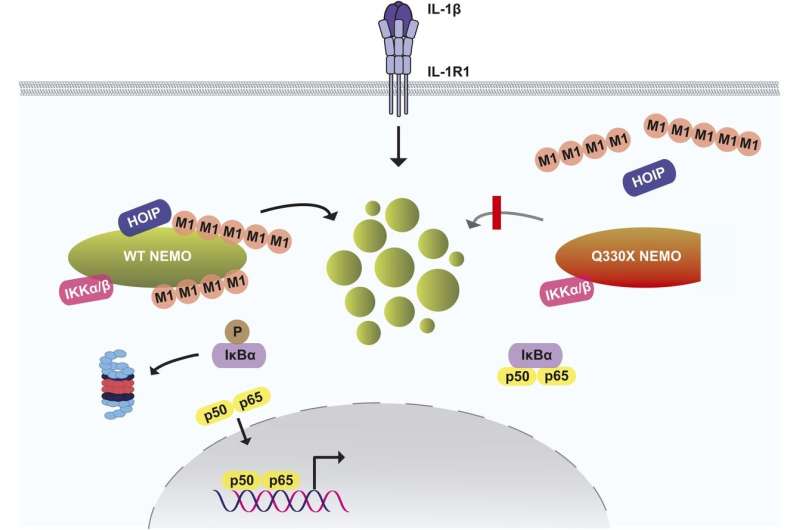Signal transmission in the immune and nervous system through NEMO

A cascade of various events is required for the transmission of signals within cells. These include several modifications of proteins to switch their function on or off. In order to ensure rapid signal transmission, signaling proteins transiently accumulate at specific sites in the cell, where they can form biomolecular condensates.
A team led by Professor Konstanze Winklhofer, head of the Department of Molecular Cell Biology at Ruhr University in Bochum, observed that the signaling protein NEMO also forms condensates and identified the underlying mechanism. These findings are crucial for understanding signaling processes in the immune and nervous systems. The researchers report on this finding in an issue of the journal Life Science Alliance on January 31, 2023.
Switching proteins on and off
A number of cellular processes are initiated by the binding of ligands, such as hormones, neurotransmitters or cytokines to specific receptors in the cell membrane. “Signal transduction has to be strictly regulated in a spacial and temporal manner, in order to trigger an appropriate cellular response on the one hand and to avoid excessive responses on the other,” explains Konstanze Winklhofer. Regulation can be achieved by temporarily modifying proteins, for example by attaching phosphate groups or chains of small ubiquitin proteins.
To facilitate rapid regulation, signaling molecules and enzymes regulating their activity can accumulate in so-called biomolecular condensates. “Think of this as a temporary accumulation of these molecules at specific sites in the cell,” says Konstanze Winklhofer. This accumulation of molecules resembles droplets without an outer barrier in form of a membrane.
NEMO needs ubiquitin chains
Konstanze Winklhofer’s research group has shown that such biomolecular condensates are formed during the activation of the transcription factor NF-κB. This transcription factor is activated by various signaling pathways, for example in innate immune responses induced by the cytokines interleukin-1 (IL-1) and tumor necrosis factor (TNF) or by a number of neurotrophic factors in the nervous system.
The protein NEMO (NF-κB essential modulator) plays a central role in the activation of NF-κB. Various NF-κB-activating stimuli trigger the formation of chains of ubiquitin molecules. NEMO binds to these chains, alters its conformation and, as a result, activates certain enzymes that are required for signal transduction.
Konstanze Winklhofer and her team have discovered that NEMO can only form biomolecular condensates when it interacts with ubiquitin chains. If the binding of NEMO to ubiquitin chains is impaired by a mutation in the NEMO gene, no condensates are formed and NF-κB is not activated.
A pathogenic mutation inhibits the function of NEMO
“We have identified a mutation in the NEMO gene located on the X chromosome that inhibits the ability of NEMO to bind to ubiquitin chains,” says Konstanze Winklhofer. As a result, NEMO is unable to promote signaling. The NEMO mutant is associated with a disease called Incontinentia pigmenti. Clinical manifestations of this disease include skin abnormalities and neurological symptoms. In male patients, this disease is usually fatal, as they have only one X chromosome.
“The characterization of this NEMO mutant in cellular models has contributed significantly to our understanding of the signaling processes involved in NF-κB activation,” says Konstanze Winklhofer. “We are currently investigating specific functions of NEMO in neuronal and immune cells and its possible role in mediating crosstalks between the nervous and immune system.”
More information:
Simran Goel et al, Linear ubiquitination induces NEMO phase separation to activate NF-κB signaling, Life Science Alliance (2023). DOI: 10.26508/lsa.202201607
Citation:
Signal transmission in the immune and nervous system through NEMO (2023, February 3)
retrieved 3 February 2023
from https://phys.org/news/2023-02-transmission-immune-nervous-nemo.html
This document is subject to copyright. Apart from any fair dealing for the purpose of private study or research, no
part may be reproduced without the written permission. The content is provided for information purposes only.
For all the latest Science News Click Here
For the latest news and updates, follow us on Google News.

